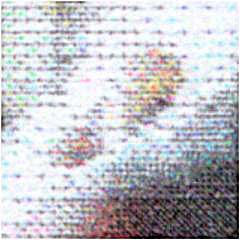The megabyte is a multiple of the unit byte for digital information. Its recommended unit symbol is MB. The unit prefix mega is a multiplier of 1000000 (106) in the International System of Units (SI). Therefore, one megabyte is one million bytes of information. This definition has been incorporated into the International System of Quantities.

In computer graphics and digital photography, a raster graphic represents a two-dimensional picture as a rectangular matrix or grid of pixels, viewable via a computer display, paper, or other display medium. A raster is technically characterized by the width and height of the image in pixels and by the number of bits per pixel. Raster images are stored in image files with varying dissemination, production, generation, and acquisition formats.

In computer graphics, rasterisation or rasterization is the task of taking an image described in a vector graphics format (shapes) and converting it into a raster image. The rasterized image may then be displayed on a computer display, video display or printer, or stored in a bitmap file format. Rasterization may refer to the technique of drawing 3D models, or to the conversion of 2D rendering primitives, such as polygons and line segments, into a rasterized format.
OpenType is a format for scalable computer fonts. Derived from TrueType, it retains TrueType's basic structure but adds many intricate data structures for describing typographic behavior. OpenType is a registered trademark of Microsoft Corporation.
The BMP file format or bitmap, is a raster graphics image file format used to store bitmap digital images, independently of the display device, especially on Microsoft Windows and OS/2 operating systems.
QuickDraw was the 2D graphics library and associated application programming interface (API) which is a core part of classic Mac OS. It was initially written by Bill Atkinson and Andy Hertzfeld. QuickDraw still existed as part of the libraries of macOS, but had been largely superseded by the more modern Quartz graphics system. In Mac OS X Tiger, QuickDraw has been officially deprecated. In Mac OS X Leopard applications using QuickDraw cannot make use of the added 64-bit support. In OS X Mountain Lion, QuickDraw header support was removed from the operating system. Applications using QuickDraw still ran under OS X Mountain Lion to macOS High Sierra; however, the current versions of Xcode and the macOS SDK do not contain the header files to compile such programmes.

Dots per inch is a measure of spatial printing, video or image scanner dot density, in particular the number of individual dots that can be placed in a line within the span of 1 inch (2.54 cm). Similarly, dots per centimetre refers to the number of individual dots that can be placed within a line of 1 centimetre (0.394 in).
Pixels per inch (ppi) and pixels per centimetre are measurements of the pixel density of an electronic image device, such as a computer monitor or television display, or image digitizing device such as a camera or image scanner. Horizontal and vertical density are usually the same, as most devices have square pixels, but differ on devices that have non-square pixels. Pixel density is not the same as resolution — where the former describes the amount of detail on a physical surface or device, the latter describes the amount of pixel information regardless of its scale. Considered in another way, a pixel has no inherent size or unit, but when it is printed, displayed, or scanned, then the pixel has both a physical size (dimension) and a pixel density (ppi).

In typography, the point is the smallest unit of measure. It is used for measuring font size, leading, and other items on a printed page. The size of the point has varied throughout printing's history. Since the 18th century, the size of a point has been between 0.18 and 0.4 millimeters. Following the advent of desktop publishing in the 1980s and 1990s, digital printing has largely supplanted the letterpress printing and has established the desktop publishing (DTP) point as the de facto standard. The DTP point is defined as 1⁄72 of an international inch (1/72 × 25.4 mm ≈ 0.353 mm) and, as with earlier American point sizes, is considered to be 1⁄12 of a pica.

Metric typographic units have been devised and proposed several times to overcome the various traditional point systems. After the French Revolution of 1789 one popular proponent of a switch to metric was Didot, who had been able to standardise the continental European typographic measurement a few decades earlier. The conversion did not happen, though. The Didot point was metrically redefined as 1⁄2660 m (≈ 0.376 mm) in 1879 by Berthold.
A computer font is implemented as a digital data file containing a set of graphically related glyphs. A computer font is designed and created using a font editor. A computer font specifically designed for the computer screen, and not for printing, is a screen font.
Windows Presentation Foundation (WPF) is a free and open-source graphical subsystem originally developed by Microsoft for rendering user interfaces in Windows-based applications. WPF, previously known as "Avalon", was initially released as part of .NET Framework 3.0 in 2006. WPF uses DirectX and attempts to provide a consistent programming model for building applications. It separates the user interface from business logic, and resembles similar XML-oriented object models, such as those implemented in XUL and SVG.
The Glyph Bitmap Distribution Format (BDF) by Adobe is a file format for storing bitmap fonts. The content takes the form of a text file intended to be human- and computer-readable. BDF is typically used in Unix X Window environments. It has largely been replaced by the PCF font format which is somewhat more efficient, and by scalable fonts such as OpenType and TrueType fonts.
The ICO file format is an image file format for computer icons in Microsoft Windows. ICO files contain one or more small images at multiple sizes and color depths, such that they may be scaled appropriately. In Windows, all executables that display an icon to the user, on the desktop, in the Start Menu, or in file Explorer, must carry the icon in ICO format.
A number of vector graphics editors exist for various platforms. Potential users of these editors will make a comparison of vector graphics editors based on factors such as the availability for the user's platform, the software license, the feature set, the merits of the user interface (UI) and the focus of the program. Some programs are more suitable for artistic work while others are better for technical drawings. Another important factor is the application's support of various vector and bitmap image formats for import and export.

The Sony Reader (ソニー・リーダー) was a line of e-book readers manufactured by Sony. The first model was the PRS-500 released in September 2006 and was related to the earlier Sony Librie, the first commercial E Ink e-reader in 2004 using an electronic paper display developed by E Ink Corporation. The last model was the PRS-T3, after which Sony announced it would no longer release a new consumer e-reader.
Bitstream Font Fusion is a small, fast, object-oriented font engine written in ANSI C capable of rendering high-quality text on any platform, any device, and at any resolution. The entire source code is portable, optimized, and executes independent of operating system and processor. The font engine is capable of rendering 2,400-3,300 characters per second on a 100 MIPS CPU.
In computing, a bitmap is a mapping from some domain to bits. It is also called a bit array or bitmap index.

The Retina display is a branded series of IPS LCD and OLED displays by Apple Inc. and have a higher pixel density than its traditional displays. Apple has registered the term "Retina" as a trademark with regard to computers and mobile devices with the United States Patent and Trademark Office and Canadian Intellectual Property Office. The applications were approved in 2012 and 2014 respectively. The Canadian application cited a 2010 application in Jamaica.
This is a glossary of terms relating to computer graphics.






